The Checker Maven
Perpetual Motion
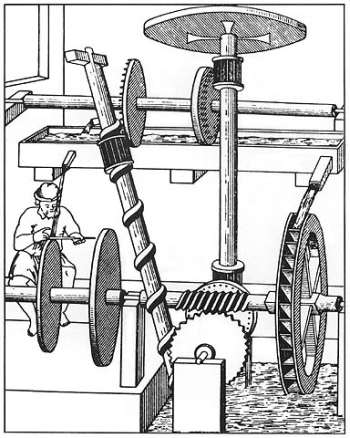
Perpetual motion, like alchemy, was a dream of scientists of a bygone era. Not equipped with the knowledge and tools of later days, they hoped to build a machine that was self-sustaining and would operate forever. Alas, such a thing is not possible; reaching 100% efficiency in the practical world simply doesn't happen, and, lacking energy input of some type, everything runs down in the end. As with the search for a way to turn base materials into gold, the quest for perpetual motion was never to succeed. Still, much time, effort, and ingenuity was expended designing devices such as the one shown above.
Perpetual motion of a different kind, however, can be found in the game of checkers. While we're not going to give away any more than that, you'll understand our meaning when you've worked through today's problem, which is diagrammed below.
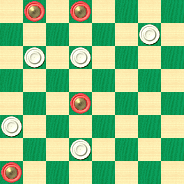
WHITE
White to Play and Draw
W:W8,9,10,21,26:BK1,K2,K18,K29.
White has five men against four kings; his extra piece is going to go fast and then four men have to face four kings. It seems hopeless, but there is a brilliant way to draw which demonstrates once again the incredible possibilities present on the checkerboard.
Don't just go through the motions; perpetuate your efforts and find the solution! And as you know, clicking on Read More is our perpetually-valid means of moving to the solution.![]()
Tangled Skeins

The title for today's Checker School lesson, taken from Ben Boland's Famous Positions in the Game of Checkers, has less to do with the position itself than with the commentary that follows it in the original book. We'll look at the position first, and we'll discuss the commentary in the solutions section of our column.
BLACK
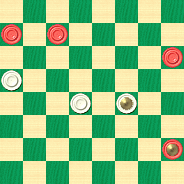
WHITE
White to Play and Draw
W:W13,18,K19:B5,6,12,K28.
White seeks to obtain a man-down draw; as usual, there are compensatory factors that must be relied upon to make up for the material deficit. Here, White's better mobility seems to be his only edge, but whether or not that's enough depends on the skill and technique of the White checkerist.
Can you untangle this one, or will it remain a knotty problem? No worries, you can click on Read More to unwind the solution, explanatory notes, and a sample game, as well as viewing the "Tangled Skeins" commentary.![]()
Russell's Crocodile

We're not at all sure we understand the title of this month's selection from Willie Ryan's Tricks Traps & Shots of the Checkerboard. The entry is labeled "Russell's Crocodile" yet it is all about the Alligator Position! Crocodiles and alligators are most assuredly different creatures; while they are varieties of crocodilians, they respectively belong to the crocodylidae family and the alligatoridae family. Furthermore, according to website wisegeek.com:
"... the crocodile's upper and lower jaws are nearly the same width, so the teeth are exposed all along the jaw line in an interlocking pattern, even when the mouth is closed ... An alligator ... has a wider upper jaw, so when its mouth is closed the teeth in the lower jaw fit into sockets of the upper jaw, hidden from view. Only the teeth of the upper jaw are exposed along the lower jaw line."
We don't know why Willie mixed his metaphor, so to speak; perhaps it is because his expertise ran stronger in checkers than it did in biology. But we can all be grateful for that, as Willie today gives us an entertaining example of the Alligator Position.
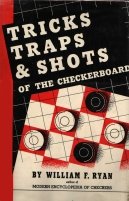
"For sheer brilliance, none of the previously illustrated sparkling gems devised by the great men of draughts shines brighter than the renowned Alligator Position. It was first published as a problem by W. H. Russell at the stage diagrammed below. Later, Southern States Champion F. B. Fishburne, of Columbia, South Carolina, showed how it could arise scientifically in play. Fishburne dubbed it the Alligator Position, 'because it had such a wicked tail-end snap,' and that appropriate appellation has held fast.
| 9-13 | 24-19 | 11-16 |
| 22-17 | 16-23 | 26-23 |
| 13-22 | 26-19 | 16-20 |
| 25-18 | 6-10 | 31-27---3 |
| 11-16 | 25-21 | 2-7---4 |
| 29-25 | 10-17 | 24-19 |
| 5-9 | 21-14 | 7-11---5 |
| 18-14 | 11-16 | 14-10 |
| 9-18 | 28-24 | 11-16 |
| 23-14 | 16-23 | 18-15 |
| 10-17 | 27-18 | 4-8---A. |
| 21-14 | 7-11 | See the |
| 8-11 | 30-26 | diagram. |
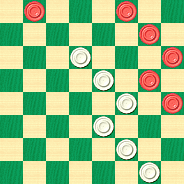
WHITE
White to Play and Win
W:W10,15,19,23,27,32:B1,3,8,12,16,20.
A---Loses, and forms the Alligator Position. 1-5 will produce a draw with careful play---6."
3---This move loses and we're surprised Willie didn't flag it. Correct was 23-19 to a probable draw. After 31-27 2-6 4-8 White cannot avoid the loss of a piece---Ed.
4---But White misses the win with 2-6---Ed.
5---The computer engine KingsRow really doesn't like this move and calls it a probable loss. 1-6 was correct---Ed.
6---However the computer sees this as a dead loss, instead choosing 3-8 in an already hopeless position. See Note 5 above---Ed.
Whatever species you may prefer--- alligator or crocodile--- can you get your teeth around this problem? After you've chewed on it for a while, snap your mouse on Read More to see the solution.![]()
Playing Hardball

Following on the heels of last month's "Two Fisted" checker problem, this month we again play real "hardball" with a position that one of the greats of checker history managed to get wrong. More about that when we discuss the solution, but first let's look at the following diagram.
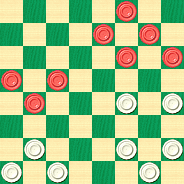
WHITE
White to Play and Win
W:W19,20,25,27,28,29,30,32:B3,7,8,11,12,13,14,17.
The originally published comment on this position was "... the following beautiful position ... appears to be a forced White win." That was something over 85 years ago. Modern computer analysis by KingsRow with the 10-piece endgame database declares the position a likely White win, but with a line of play different from the one published decades back.
In the solution, reached by clicking on Read More, we'll show you the computer line and give you a little more historical background. But first, we invite you to do your own analysis, and at the very least, decide how you would play the position. Certainly, it's a practical exercise, and although indeed we're playing hardball in asking you to do better than one of the game's leading champions of yore, the solution is surprisingly accessible.![]()
Mayday 2010

In previous years, at this point on the calendar, we've explored the various meanings of both the term "Mayday!" and the various festivals that take place on the first day of May. And, although we've looked at the political aspects before, having come across the photo above, we can't help but revisit the topic once again.
The photo is of the enormous and elaborate "First of May Stadium" found in Pyonyang, the capital of the euphemistically-named Democratic People's Republic of Korea (DPRK), better known simply as "North Korea." The photo makes us marvel at the ability of this nation to build huge monuments to Communism and to its own maniacal leadership; to invest heavily in military "defense"; and most of all, to carry out an active nuclear weapons development program--- yet at the same time to be utterly unable to do something as basic as to keep its own people from starving. North Korea is neither "democratic" nor a "people's republic"; it is something both far less and far worse.
As we've so often said, The Checker Maven makes no excuse for standing up in the name of freedom and liberty.
But what has all this to do with checkers? Quite a lot, actually. If you want to think about what is truly "democratic" and what is truly for "the people" then there is little better a model than the game of checkers. It's democratic: anyone can play, and anyone can succeed to whatever degree they wish to work toward that success. It's for the people: checkers is a game that is very easy to learn, incredibly inexpensive, and wholesome, intellectual, and entertaining all at once.
In fact we'd like to suggest the "checkers model" for government, wherein all "men" are created equally, with no special powers or privileges except those earned through the hard work of making his or her way to the crowning row.
All that said, we know you'd like to see your weekly checker problem, and instead of the usual monthly speed problem, we've chosen a problem that is rather easy but still a bit beyond something that should be solved against the clock.
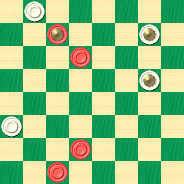
BLACK
Black to Play and Win
B:W12,32,K17,K25:B3,7,23,K27.
Now, this is a democracy, and as one of the "people" you can exercise freedom of choice in selecting your moves. Can you lead the beleaguered force of Black freedom fighters to a win against the army of the White tyrant? Although no one is going to build a huge stadium in your honor if you succeed, we hope you'll try it anyhow, and then click on Read More to see the solution.![]()
